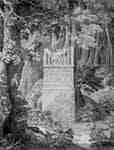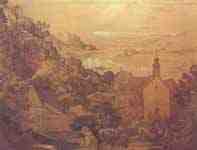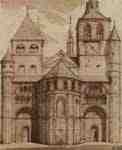Johann Anton Ramboux
The Stigmatisation of Saint Francis

Christ on the Cross in the Church of S. Domenico in Arezzo

Saint Catherine of Siena Rescues Two Dominicans from the Hands of Robbers


Saint Francis Preaching to the Birds

Rebecca and Eliezer at the Well
Drawings

Bollendorf (Eifel), Roman Diana memorial

Trier, view over Pallien to the Moselle valley

Trier, Cathedral from the West
Fine Art Prints | Greeting Cards | Phone Cases | Lifestyle | Face Masks | Men's , Women' Apparel | Home Decor | jigsaw puzzles | Notebooks | Tapestries | ...
The Stigmatisation of Saint Francis
Johann Anton Alban Ramboux (5 October 1790, Trier - 2 October 1866, Cologne) was a German painter and lithographer.
Life
His father came from Savoy and his mother was from a famous family of goldsmiths. Christoph Hawich, his drawing teacher at the Bürgerschule (a sort of commercial prep-school) in Trier noted his artistic talent. As a result, in 1803 he received a recommendation to study with Jean-Henri Gilson (1741-1809), a former Benedictine monk who taught art in Florenville.[1] After four years there, he received a further recommendation to study with Jacques-Louis David in Paris, where Ramboux remained until 1812. In 1815, he was admitted to the Academy of Fine Arts, Munich, becoming a pupil of Konrad Eberhard.
The Eberhard Brothers (1822)
In 1816 he moved to Rome, where he lived until 1822. While there, he made the acquaintance of many fellow painters who were involved in the Nazarene movement. He returned to Trier for ten years, creating hundreds of watercolors of the city and the Moselle River, which he began reproducing as lithographs in 1825. In 1832, he began another ten-year stay in Italy, producing landscapes and folk-scenes as well as copies of Renaissance frescoes and mosaics.[2]
Work in Cologne
In 1843, a curator was needed for the Wallraf Collection (now the Wallraf-Richartz Museum) in Cologne and Ramboux was recommended for the position by Johann Gottfried Schadow. He was appointed and took office in 1844.[1] Ten years later, he was able to make a long-desired pilgrimage to Jerusalem, producing hundreds of watercolors and lithographs along the way.[2] In 1858, he was made the first Honorary Citizen of Trier.
Adam and Eve after the Expulsion from Paradise (c.1818)
A street is named after him in the Longerich district of Cologne. Since 1961, the City of Trier has awarded the Ramboux Prize to promote the development of young artists.
Selected writings
Beiträge zur Kunstgeschichte der Malerei (Contributions to the History of Painting, Cologne, 1860 (300 pages)
Umrisse zur Veranschaulichung altchristlicher Kunst in Italien vom Jahr 1200–1600 (Outline of Early Christian Art in Italy), Cologne, 1854 (125 pages)[2]
References
Alina Dobrzecki-Langer (2003), "Ramboux, Johann Anton", Neue Deutsche Biographie (NDB) (in German) 21, Berlin: Duncker & Humblot, pp. 129–130; (full text online)
J. J. Merlo (1888), "Ramboux, Johann Anton", Allgemeine Deutsche Biographie (ADB) (in German) 27, Leipzig: Duncker & Humblot, pp. 208–210
Further reading
Christina A. Schulze: Museum Ramboux - Eine italienische Stilgeschichte in Kopien von Johann Anton Ramboux (1790 - 1866) an der Königlichen Kunstakademie Düsseldorf (1841 - 1918), Dissertation, Vienna 2011.
Johann Anton Ramboux. Maler und Konservator. 1790–1866. Wallraf-Richartz-Museum, Cologne 1966.
Eberhard Zahn: Johann Anton Ramboux in Trier. Spee-Verlag, Trier 1980.
Jens Christian Jensen: Aquarelle und Zeichnungen der deutschen Romantik. DuMont Buchverlag, Cologne 1992, pg.177, ISBN 3-7701-0976-7.
Trierer biographisches Lexikon, Landesarchivverwaltung Koblenz (2000) ISBN 3-931014-49-5, pg. 353
Édouard Hizette, Johann Anton Ramboux : fils spirituel d'Abraham Gilson, Weyrich édition, 2013.
----
Fine Art Prints | Greeting Cards | Phone Cases | Lifestyle | Face Masks | Men's , Women' Apparel | Home Decor | jigsaw puzzles | Notebooks | Tapestries | ...
----
Artist
A - B - C - D - E - F - G - H - I - J - K - L - M -
N - O - P - Q - R - S - T - U - V - W - X - Y - Z
Retrieved from "http://en.wikipedia.org/"
All text is available under the terms of the GNU Free Documentation License



